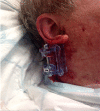The iTClamp in the treatment of prehospital craniomaxillofacial injury: a case series study
- PMID: 30635996
- PMCID: PMC6420914
- DOI: 10.5249/jivr.v11i1.917
The iTClamp in the treatment of prehospital craniomaxillofacial injury: a case series study
Abstract
Background: Craniomaxillofacial (CMF) injuries are very common in both civilian and military settings. Nearly half of all civilian trauma incidents include a scalp laceration and historical rates of CMF battle injuries increased from 16%-21% to 42.2%. The scalp is highly vascular tissue and uncontrolled bleeding can lead to hypotension, shock and death. Therefore, enabling on-scene providers, both military and civilian, to immediately manage scalp and face lacerations, in a manner that allows them to still function in a tactical way, offers operational advantages. This case series examines how effectively a wound-clamp (iTClamp) controlled bleeding from CMF injuries pre-hospital environment.
Methods: The use of the iTClamp for CMF (scalp and face laceration) was extracted from iTrauma Care's post market surveillance database. Data was reviewed and a descriptive analysis was applied.
Results: 216 civilian cases of iTClamp use were reported to iTrauma Care. Of the 216 cases, 37% (n=80) were for control of CMF hemorrhage (94% scalp and 6% face). Falls (n=24) and MVC (n=25) accounted for 61% of the mechanism of injury. Blunt accounted for 66% (n=53), penetrating 16% (n=13) and unknown 18% (n=14). Adequate hemorrhage control was reported in 87.5% (n=70) of cases, three respondents reported inadequate hemorrhage control and in seven cases hemorrhage control was not reported. Direct pressure and packing was abandoned in favor of the iTClamp in 27.5% (n=22) of cases.
Conclusions: CMF injuries are common in both civilian and military settings. Current options like direct manual pressure (DMP) often do not work well, are formidable to maintain on long transports and Raney clips are a historical suggestion. The iTClamp offers a new option for control of external hemorrhage from open wounds within compressible zones.
Conflict of interest statement
Figures






References
-
- Hardaway RM. 3rd Viet Nam wound analysis. J Trauma. 1978;18(9):635–43. - PubMed
-
- Chan RK, Siller-Jackson A, Verrett AJ, Wu J, Hale RG. Ten years of war: a characterization of craniomaxillofacial injuries incurred during operations Enduring Freedom and Iraqi Freedom. J Trauma Acute Care Surg. 2012;73(6 Suppl 5):S453–8. - PubMed
-
- Turnage B, Maull KI. Scalp laceration: an obvious 'occult' cause of shock. South Med J. 2000 Mar;93(3):265–6. - PubMed
MeSH terms
LinkOut - more resources
Full Text Sources
Medical

